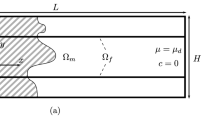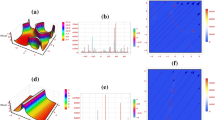Abstract
In this paper, we employ the novel application of a reaction-diffusion model on a growing domain to examine growth patterns of the ligaments of arcoid bivalves (marine molluscs) using realistic growth functions. Solving the equations via a novel use of the finite element method on a moving mesh, we show how a reaction-diffusion model can mimic a number of different ligament growth patterns with modest changes in the parameters. Our results imply the existence of a common mode of ligament pattern formation throughout the Arcoida. Consequently, arcoids that share a particular pattern cannot be assumed, on this basis alone, to share an immediate common ancestry. Strikingly different patterns within the set can easily be generated by the same developmental program. We further show how the model can be used to make quantitatively testable predictions with biological implications.
Similar content being viewed by others
References
Baines, M. J. (1994). Moving Finite Elements, Monographs on Numerical Analysis, Oxford: Clarendon Press.
Baines, M. J. and A. J. Wathen (1988). Moving finite element methods for evolutionary problems. I. Theory. J. Comp. Phys. 79, 245–269.
Crampin, E. J. (2000). Reaction-diffusion patterns on growing domains. D Phil thesis, University of Oxford.
Crampin, E. J., E. A. Gaffney and P. K. Maini (2001). Mode-doubling and tripling in reaction-diffusion patterns on growing domains: a piecewise linear model. J. Math. Biol., in press.
Edelstein-Keshet, L. (1988). Mathematical Models in Biology, New York: Random House.
Ermentrout, B., J. Campbell and G. Oster (1986). A model for shell patterns based on neural activity. Veliger 28, 369–388.
Geirer, A. and H. Meinhardt (1972). A theory of biological pattern formation. Kybernetik 12, 30–39.
Jimack, P. K. and A. J. Wathen (1991). Temporal derivatives in the finite-element method on continuously deforming grids. SIAM J. Numer. Anal. 28, 990–1003.
Kiskaddon, L. (1996). Computer simulations of arcoid ligaments. Unpublished report on independent study, Franklin and Marshall College, Lancaster, Pa., 20p. + computer file.
Kondo, S. and R. Asai (1995). A reaction-diffusion wave on the skin of the marine angelfish. Pomacanthus, Nature 376, 765–768.
MacNeil, F. S. (1937). The systematic position of the pelecypod genus. Trinacria. J. Washington Acad. Sci. 27, 452–458.
Madzvamuse, A. (2000). A numerical approach to the study of spatial pattern formation. D Phil thesis, University of Oxford.
Meinhardt, H. and M. Klinger (1987). A model for pattern formation on the shells of molluscs. J. Theor. Biol. 126, 63–69.
Meinhardt, H. (1995). The Algorithmic Beauty of Sea Shells, Heidelberg, New York: Springer.
Morton, K. W. and D. F. Mayers (1994). Numerical Solution of Partial Differential Equations, Cambridge University Press.
Müller, J. D., P. L. Roe and H. Deconinck (1993). A frontal approach for internal node generation for Delaunay triangulations. Int. J. Numer. Methods Fluids 17, 241–256.
Murray, J. D. (1993). Mathematical Biology, Heidelberg, New York: Springer.
Newell, N. D. (1937). Late Paleozoic pelecypods: Pectinacea. Kansas Geological Survey, Publications 10, 1–123.
Newell, N. D. (1969). Family Noetiidae Stewart, 1930, in Treatise on Invertebrate Paleontology, R. C. Moore, (Ed.) (Part N, Mollusca 6), Geological Society of America and University of Kansas, pp. 261–264.
Oster, G. F., N. Shubin, J. D. Murray and P. Alberch (1988). Evolution and morphogenetic rules: the shape of the vertebrate limb in ontogeny and phylogeny. Evolution 42, 862–884.
Painter, K. J. (1997). Chemotaxis as a mechanism for Morphogenesis. D Phil thesis, University of Oxford.
Reddy, J. N. (1984). An Introduction to the Finite Element Method, McGraw-Hill.
Saad, Y. (1996). Iterative Methods for Sparse Linear Systems, PWS Publishing Company.
Schnakenberg, J. (1979). Simple chemical reaction systems with limit cycle behaviour. J. Theor. Biol. 81, 389–400.
Thomas, D. (1975). Artificial enzyme membrane, transport, memory, and oscillatory phenomena, in Analysis and Control of Immobilised Enzyme Systems, D. Thomas and J. P. Kervenez (Eds), Berlin, Heidelberg, New York: Springer, pp. 115–150.
Thomas, R. D. K. (1976). Constraints of ligament growth, form and function on evolution in the Arcoida (Mollusca: Bivalvia). Paleobiology 2, 64–83.
Thomas, R. D. K., A. Madzvamuse, P. K. Maini and A. J. Wathen (2000). Growth Patterns of Noetiid Ligaments: Implications of Developmental Models for the Origin of an Evolutionary Novelty Among Arcoid Bivalves, The Evolutionary Biology of the Bivalvia, E. M. Harper, J. D. Taylor and J. A. Crame, (Eds) (Special Publications 177), Geological Society, London, pp. 289–279.
Thompson, D. W. (1917). On Growth and Form, 1st edn, Cambridge: Cambridge University Press.
Trueman, E. R. (1969). Ligament, in Treatise on Invertebrate Paleontology, R. C. Moore, (Ed.) Geological Society of America and University of Kansas (Part N, Mollusca 6), pp. 58–64.
Turing, A. M. (1952). The chemical basis of morphogenesis. Phil. Trans. Roy. Soc. Lond. B 237, 37–72.
Author information
Authors and Affiliations
Rights and permissions
About this article
Cite this article
Madzvamuse, A., Thomas, R.D.K., Maini, P.K. et al. A numerical approach to the study of spatial pattern formation in the ligaments of arcoid bivalves. Bull. Math. Biol. 64, 501–530 (2002). https://doi.org/10.1006/bulm.2002.0283
Received:
Accepted:
Issue Date:
DOI: https://doi.org/10.1006/bulm.2002.0283




